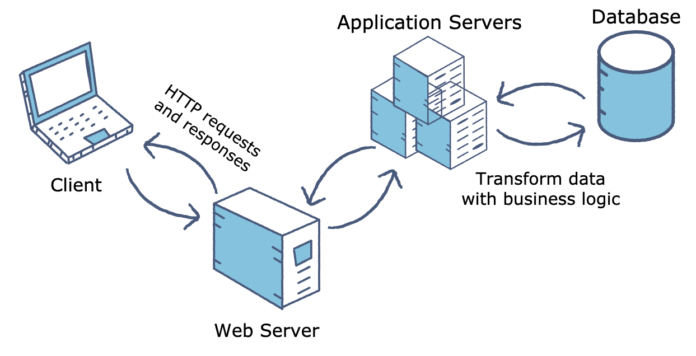An application server is a powerful computer used to provide application resources to users and web clients in a world where many business operations are dependent on it. Typically, application servers are located between the database servers that store application data and the web servers that communicate with clients. An application server and similar middleware are the operating systems that facilitate the creation and delivery of an application. Application servers are key in connecting a world of devices, whether a desktop, mobile or online.
Applications are stored and operated on application servers, which are network computers. Application servers take up a significant amount of computational resources between database servers and the end user. We may name this “middleware,” a general term for what these things accomplished.
Early on, it was discovered that the program creators were utilizing to get their job done was getting more and more difficult to design as well as maintain. For apps to share more data and occasionally functionality, there was a growing push to do so. Increasing numbers of apps were either placed on a network or utilized heavily through networks. A structured and effective method of distributing application capabilities and making it simpler to build, operate, and maintain apps sounded like a good idea.
Web Servers vs. Application Servers
To put it simply, a web server’s primary function is to receive and fulfill requests for static material from a website (HTML pages, files, images, video, and so on). The request comes from a web browser or mobile app, and both the server’s and client’s responses are in the form of HTTP messages.
What is usually referred to as “business logic” provides dynamic content; that is, it’s code that changes data to give the particular functionality a company, service, or application provides. It is common for an application server’s clients to be other application servers as well as web servers. As with web server-client communication, the application server and its clients may exchange HTTP messages, but they aren’t needed to do so. Other protocols, like as CGI versions, are also popular.
Benefits of Application Servers
Every day, hundreds of millions of online users expect to be able to access any program they can think of. No matter what program you’re using, it’s being retrieved from an application server and served up through a web server, no matter what time of day it is. Web servers are in charge of responding to HTTP requests from web clients. In contrast to app servers, the web server architecture is small enough to handle static data requests for various apps (or websites) while ensuring security. Additional support is needed for dynamic requests, sometimes in the form of apps.
Managing HTTP requests from web clients and forwarding or keeping resources from various websites does not work for optimum web server agility. Servers designed specifically for serving up dynamic online content fill this need.
Application servers provide additional security and redundancy. The task of conserving and replicating application architecture over the network becomes easier if the database and web server are connected. In addition to protecting the database server’s crown jewels, an additional layer of protection is provided through a third-party intermediary. Since business logic queries may be handled by application servers, attempting a SQL injection is considerably more difficult.
Organizations may further safeguard their data with a reverse proxy server in front of their databases. It is possible to safeguard customers and corporate data with the use of proxy servers and virtual private networks (VPNs).
Bottom Line
In today’s application infrastructure and middleware market cloud platforms and services and the explosion of Internet of Things (IoT) are revolutionizing the scope. A remote workforce that relies on improved connection and operational efficiency, as well as a shift toward BYOD rules, further adds to the complexity. Thus, there’s no denying these robust modules’ importance in providing customer application resources.






















